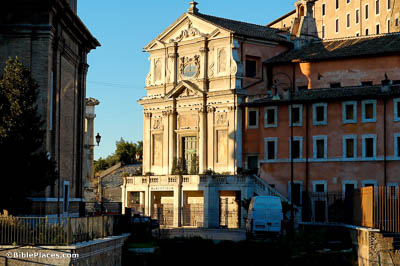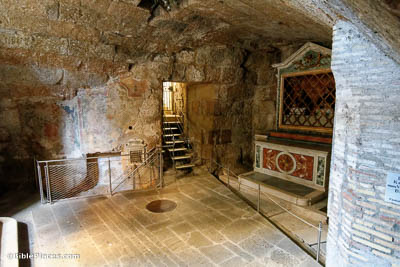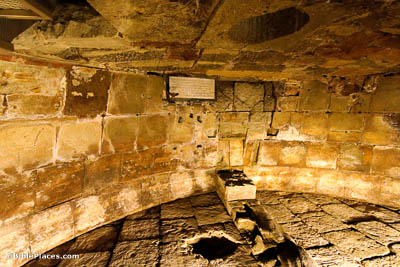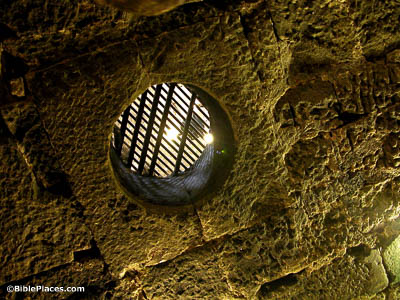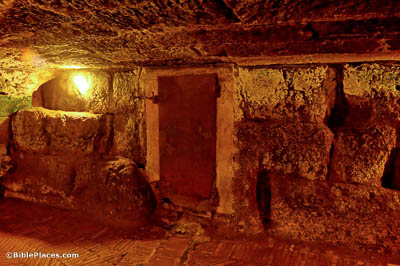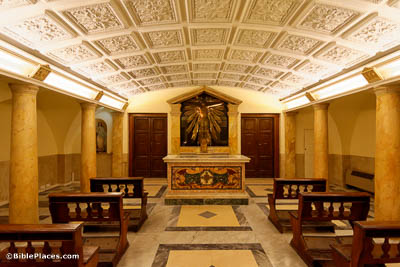Just north of the Forum in Rome stands San Giuseppe dei Falegnami (St. Joseph’s of the Carpenters), a Roman Catholic church dedicated to Jesus’s foster father, Joseph of Nazareth. Beneath this structure are the remains of the traditional site of the imprisonments of the Apostle Paul and the Apostle Peter in Rome. This prison was simply known as “Carcer” (“prison”) in Paul’s day. The term “Mamertine” was attributed to the prison in the Medieval Period.
Mamertine Prison
Upper Chamber
The Carcer was the only prison in ancient Rome. When someone was sentenced to death, they were brought here to await execution. Pictured here is the upper chamber of the ancient prison. Though it is now subterranean, this section of the Carcer was once at street level.
Tullianum
Below the upper chamber is a circular room called the Tullianum. This structure may have held religious importance even before the days of the apostles; votive offerings were found during excavations, indicating ceremonial activity from the period before it was linked to the Carcer.
Access to the Chamber
Before the stairs were added, those prisoners who entered the Tullianum from the Carcer were lowered through a hole in the Carcer’s floor. The name “Tullianum” is probably derived from the Latin word for a spring of water, and incidentally, this section of the prison does, in fact, house a well. According to tradition, the apostle Peter caused the well-water to spring up so that he might baptize his jailors, St. Processus and St. Martinianus. It is debated, however, whether Peter was actually incarcerated here.
Executions
The state rarely incarcerated common criminals, but kept the Mamertine Prison for political prisoners doomed for execution by being thrown off the Tarpeian Rock. Enemies of the State, such as Jugurtha and Vercingetorix, were often strangled in the Tullianum. A door in the chamber offered access to the Cloaca Maxima (Rome’s sewer system), and it is thought that the bodies of executed prisoners may have been carried out through there.
Continued Interest
Because of its association with Paul and Peter, the Mamertine Prison has been used as a place of worship since roughly the 7th century. This chapel, which sits above the Carcer’s upper chamber, was established as a place to house the ornate crucifix which once adorned the structure’s façade.

Download all of our Rome photos!
$24.00 $29.99 FREE SHIPPING
Related Websites
See also Philippi and Caesarea Maritima. For a related Bible chapter, see Acts 28.
Because of the deep uncertainty surrounding many aspects of Mamertine, the available resources often contradict each other. As with all historical and archaeological interpretations, the following articles (and all linked resources on this site) should be treated with healthy alertness and caution.
Mamertine Prison (Tour of Rome). This page offers a short description of the site and its surrounding tradition, alongside a few interesting photos taken before the recent renovation.
Mamertine Prison, Rome (Sacred Destinations). A slightly longer overview written with more of an ear toward tradition.
Archaeologists Reveal Secrets of Roman Prison That Held Both Christian Saints and Jewish Rebels (Haaretz). This article focuses on the archaeological finds at Mamertine and the theories surrounding those finds.
A Dispatch from Rome: The Mamertine Prison (Foucault 13/13). Another take on the site, this time emphasizing aspects of Roman justice.
